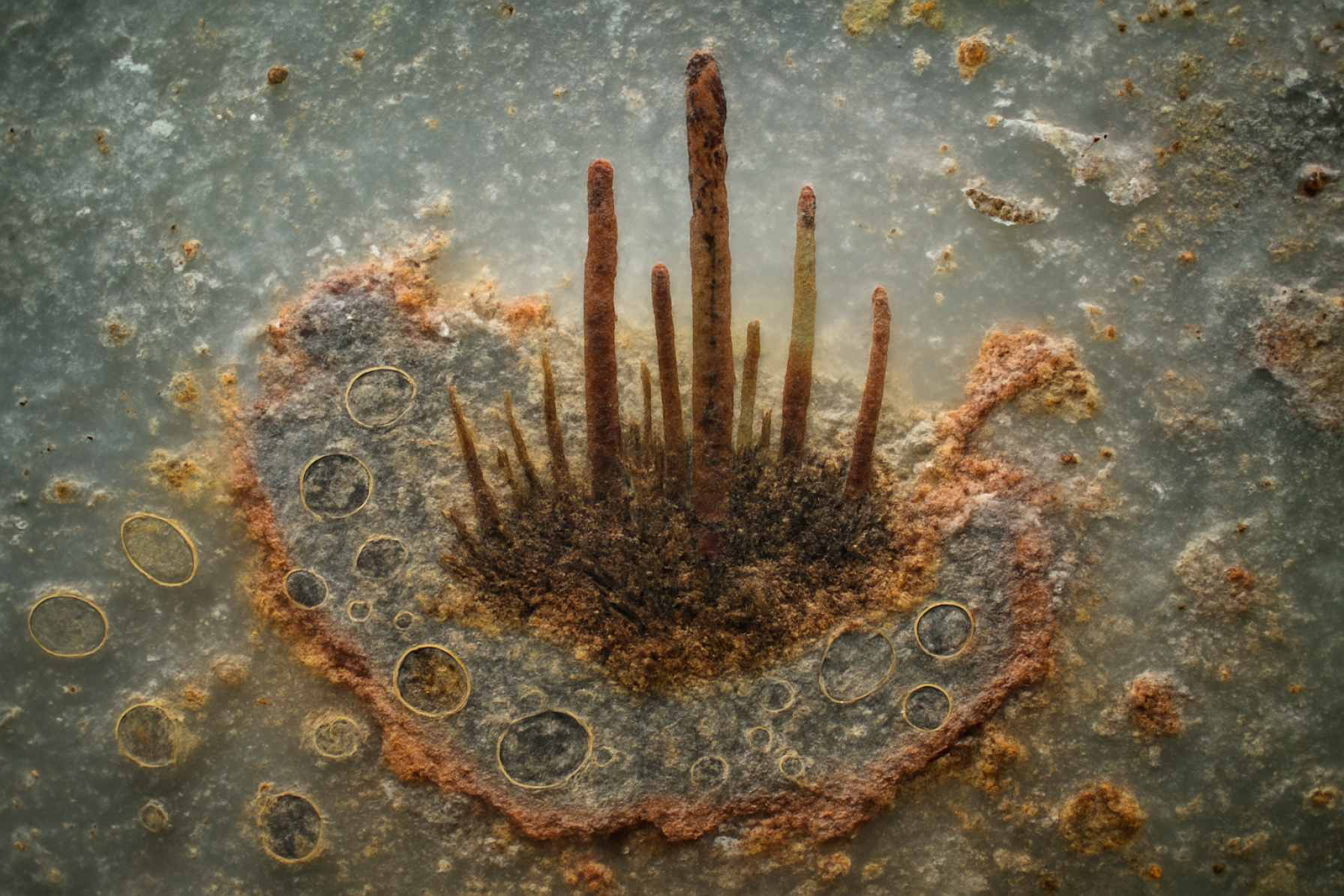The Rhynie Chert: A Window Into Earth’s Earliest Ecosystems. Discover How This Scottish Fossil Bed Revolutionizes Our Understanding of Prehistoric Life and Plant Evolution. (2025)
- Introduction: The Geological Marvel of Rhynie Chert
- Discovery and Historical Significance
- Geological Formation and Composition
- Fossilized Life: Plants, Fungi, and Early Animals
- Preservation Techniques: Why Rhynie Chert is Unique
- Scientific Breakthroughs and Key Research Findings
- Technological Advances in Chert Analysis
- Rhynie Chert’s Role in Understanding Early Terrestrial Ecosystems
- Public Interest and Educational Outreach (Estimated Growth: 15% over 5 years)
- Future Prospects: Ongoing Research and Global Scientific Impact
- Sources & References
Introduction: The Geological Marvel of Rhynie Chert
The Rhynie chert is a renowned Early Devonian sedimentary deposit located near the village of Rhynie in Aberdeenshire, Scotland. Dating back approximately 407 million years, this geological formation is celebrated for its exceptional preservation of early terrestrial ecosystems, including some of the earliest known land plants, fungi, and arthropods. The chert itself is a form of silica-rich rock, formed through the rapid precipitation of silica from hydrothermal springs, which encapsulated and fossilized the living organisms in remarkable detail. This unique mode of preservation has provided scientists with an unparalleled window into life during a critical period of Earth’s history, when plants and animals were first colonizing land.
Discovered in the early 20th century, the Rhynie chert has since become a focal point for paleobotanical and paleontological research. The site’s fossils include primitive vascular plants such as Rhynia, Aglaophyton, and Horneophyton, as well as early fungi and a variety of arthropods, including springtails and the enigmatic Palaeomyces. The extraordinary fidelity of preservation—down to cellular and subcellular structures—has enabled detailed studies of plant anatomy, reproductive strategies, and symbiotic relationships, such as those between plants and mycorrhizal fungi. These insights have been instrumental in reconstructing the evolutionary steps that led to the modern terrestrial biosphere.
The Rhynie chert is not only significant for its paleontological treasures but also for its geological context. The deposit formed in a hot-spring environment, similar to modern hydrothermal systems like those found in Yellowstone National Park. This setting facilitated the rapid silicification of organisms, preserving them before decay could occur. The study of the Rhynie chert has therefore contributed to our understanding of fossilization processes and the conditions necessary for exceptional preservation, known as Lagerstätten.
Research at the Rhynie chert site is coordinated by institutions such as the Natural History Museum and the British Geological Survey, both of which play key roles in geological and paleontological investigations in the United Kingdom. The ongoing study of the Rhynie chert continues to yield new discoveries, making it a cornerstone in the field of early terrestrial life and a geological marvel of global significance.
Discovery and Historical Significance
The Rhynie chert is a renowned Early Devonian sedimentary deposit located near the village of Rhynie in Aberdeenshire, Scotland. Its discovery dates back to 1912, when Dr. William Mackie, a Scottish geologist, first identified the unusual siliceous rock outcrops in the area. Subsequent excavations and research, particularly by Robert Kidston and William Henry Lang in the 1910s and 1920s, revealed the extraordinary paleontological significance of the site. The Rhynie chert preserves an unparalleled assemblage of fossilized plants, fungi, and animals, all entombed in fine-grained silica, providing a unique window into terrestrial ecosystems approximately 407 million years ago during the Early Devonian period.
The historical significance of the Rhynie chert lies in its exceptional preservation of early land-based life. Unlike most fossil deposits, the chert’s rapid silicification process—likely due to hot spring activity—captured organisms in exquisite cellular detail. This has allowed paleobotanists and paleontologists to study the anatomy and ecology of some of the earliest vascular plants, such as Rhynia, Aglaophyton, and Asteroxylon, as well as primitive arthropods and fungi. The site is particularly notable for providing the earliest direct evidence of plant-fungal symbiosis (mycorrhizae) and for documenting the complexity of early terrestrial food webs.
The Rhynie chert has played a pivotal role in shaping our understanding of the colonization of land by plants and associated organisms. Its fossils have informed evolutionary biology, paleobotany, and earth sciences, offering insights into the adaptation strategies that enabled life to thrive outside aquatic environments. The site continues to be a focus of international research, with ongoing excavations and advanced imaging techniques revealing new details about early terrestrial ecosystems. The importance of the Rhynie chert is recognized by major scientific organizations, including the Natural History Museum in London and the British Geological Survey, both of which have contributed to research and public education about the site.
In summary, the discovery of the Rhynie chert marked a milestone in paleontological history, providing a rare and detailed record of life’s early steps onto land. Its continued study not only enriches our understanding of Devonian ecosystems but also underscores the importance of exceptional fossil sites in reconstructing the history of life on Earth.
Geological Formation and Composition
The Rhynie chert is a renowned Early Devonian sedimentary deposit located near the village of Rhynie in Aberdeenshire, Scotland. Its geological formation dates back approximately 407 million years, during the Pragian stage of the Devonian period. The chert is primarily composed of microcrystalline silica (SiO2), which precipitated from silica-rich hydrothermal waters associated with ancient hot spring systems. This unique environment facilitated the exceptional preservation of early terrestrial ecosystems, including plants, fungi, and arthropods, in remarkable anatomical detail.
Geologically, the Rhynie chert is part of the larger Rhynie Basin, a small sedimentary basin that developed along active fault lines. The basin was periodically inundated by silica-saturated waters from hot springs, which rapidly encased living organisms and sediment in amorphous silica. Over time, this silica gel lithified into chert, a hard, dense rock. The chert layers are interbedded with other sedimentary rocks such as shales and sandstones, reflecting episodic changes in the depositional environment. The presence of sinter deposits and geyserite further supports the interpretation of a hydrothermal origin, analogous to modern hot spring systems like those found in Yellowstone National Park.
The mineralogical composition of the Rhynie chert is dominated by chalcedony and quartz, both forms of silica. The fine-grained nature of the silica matrix is crucial for the preservation of cellular and subcellular structures in fossilized organisms. In addition to silica, minor components such as iron oxides and clay minerals are present, often imparting subtle coloration to the rock. The chert’s exceptional preservation is attributed to the rapid permineralization process, where silica infiltrated and replaced organic tissues before significant decay could occur.
The Rhynie chert is of immense scientific importance because it provides a rare window into early terrestrial life and the interactions between organisms and their environment. The site has been the focus of extensive research by geologists and paleontologists, notably from institutions such as the British Geological Survey and the Natural History Museum in London. These organizations have contributed to the understanding of the chert’s formation, composition, and paleobiological significance, making the Rhynie chert a key reference point in studies of early land ecosystems and the evolution of life on Earth.
Fossilized Life: Plants, Fungi, and Early Animals
The Rhynie chert, a renowned Early Devonian sedimentary deposit located near Rhynie, Scotland, is one of the world’s most significant paleontological sites for understanding early terrestrial ecosystems. Dating to approximately 407 million years ago, the chert preserves an extraordinary array of fossilized life, including some of the earliest known land plants, fungi, and animal life. The exceptional preservation is due to rapid silicification from hot spring activity, which encapsulated organisms in fine-grained silica, allowing for cellular and even subcellular detail to be retained.
Among the most prominent fossils are early vascular plants such as Rhynia, Aglaophyton, and Asteroxylon. These plants exhibit primitive features, including simple branching stems and rudimentary vascular tissues, providing crucial insights into the evolution of land plants from their aquatic ancestors. The Rhynie chert flora demonstrates the early development of plant structures such as stomata and cuticles, adaptations essential for terrestrial life. The site also preserves evidence of early plant reproduction, including spores and sporangia, which are vital for reconstructing the life cycles of these ancient organisms.
Fungi are another key component of the Rhynie chert biota. Fossils of chytrids, zygomycetes, and glomeromycetes have been identified, some of which formed symbiotic relationships with plants. Notably, the presence of arbuscular mycorrhizal fungi—similar to those found in modern ecosystems—suggests that plant-fungal mutualisms were already established in the Early Devonian. These interactions likely played a critical role in the colonization of land by plants, facilitating nutrient uptake in challenging terrestrial environments.
The Rhynie chert also preserves some of the earliest terrestrial animals, including primitive arthropods such as springtails (Collembola), mites, and the enigmatic Palaeomyzostomum. These fossils provide rare evidence of early animal life on land and their ecological interactions with plants and fungi. For example, some arthropods are found in association with decaying plant material, indicating detritivorous feeding habits, while others may have been predators or parasites.
The unique fossil assemblage of the Rhynie chert has made it a reference point for studies of early terrestrial ecosystems and the co-evolution of plants, fungi, and animals. Ongoing research continues to reveal new taxa and interactions, deepening our understanding of the complex web of life that emerged as organisms adapted to life on land. The site is recognized and protected as a geological and paleontological treasure by organizations such as the British Geological Survey, which supports research and conservation efforts at Rhynie.
Preservation Techniques: Why Rhynie Chert is Unique
The Rhynie chert, a renowned Early Devonian sedimentary deposit located near Rhynie, Scotland, is celebrated for its exceptional preservation of ancient terrestrial ecosystems. What sets the Rhynie chert apart from other fossil sites is its unique mode of preservation, which has enabled scientists to study some of the earliest land plants, fungi, and arthropods in remarkable anatomical detail. The chert’s preservation techniques are primarily attributed to rapid silicification, a process in which silica-rich hydrothermal waters percolated through the local environment, encasing living organisms and their immediate surroundings in microcrystalline quartz almost instantaneously.
This rapid silicification is believed to have occurred in a hot spring setting, similar to modern geothermal areas such as Yellowstone National Park. The hydrothermal fluids, supersaturated with dissolved silica, would have inundated the local biota, precipitating silica directly onto and within the tissues of plants, fungi, and animals. This process not only preserved the external morphology but also the internal cellular structures, including cell walls, spores, and even subcellular details. As a result, the Rhynie chert provides a three-dimensional, permineralized snapshot of life from over 400 million years ago, offering insights into the anatomy, ecology, and evolutionary relationships of early terrestrial organisms.
Unlike typical fossilization, which often results in compression fossils or casts, the Rhynie chert’s permineralization preserves organisms in situ, sometimes even in the act of growth or interaction. This has allowed paleobotanists and paleomycologists to reconstruct entire ecosystems, including the spatial relationships between plants, fungi, and arthropods. The fidelity of preservation is so high that researchers have been able to identify symbiotic relationships, such as mycorrhizal associations between fungi and plant roots, and to study the earliest evidence of plant vascular tissues.
The significance of the Rhynie chert’s preservation techniques extends beyond paleontology. It serves as a model for understanding fossilization processes in other silica-rich environments and provides a reference point for interpreting the early colonization of land by plants and their associated organisms. The site’s scientific importance is recognized by organizations such as the British Geological Survey, which has conducted extensive research and conservation efforts at Rhynie. The Rhynie chert remains a benchmark for exceptional fossil preservation, offering a rare and invaluable window into the dawn of terrestrial life.
Scientific Breakthroughs and Key Research Findings
The Rhynie chert, a renowned Early Devonian sedimentary deposit in Aberdeenshire, Scotland, continues to be a focal point for paleobotanical and paleomicrobiological research. In 2025, several scientific breakthroughs have further illuminated the significance of this 407-million-year-old fossil site, which preserves an unparalleled snapshot of early terrestrial ecosystems. The chert’s exceptional preservation of plants, fungi, and arthropods at the cellular level has enabled researchers to reconstruct ancient life with remarkable detail.
One of the most significant recent findings involves the discovery of new fungal symbioses within the Rhynie chert. Advanced imaging and geochemical analyses have revealed previously unrecognized associations between early land plants and mycorrhizal fungi. These findings support the hypothesis that such symbiotic relationships were crucial for the colonization of terrestrial environments by plants, facilitating nutrient uptake in nutrient-poor soils. This research, conducted by collaborative teams from leading European universities and supported by the Natural History Museum, underscores the evolutionary importance of plant-fungal partnerships in shaping early terrestrial ecosystems.
Another breakthrough in 2025 centers on the identification of new arthropod species within the chert. Using high-resolution synchrotron tomography, scientists have reconstructed the three-dimensional morphology of minute arthropods, revealing complex anatomical adaptations for terrestrial life. These discoveries provide direct evidence of the early diversification of arthropods and their ecological roles in Devonian ecosystems. The work, coordinated with the British Geological Survey, highlights the Rhynie chert’s value as a window into the evolutionary experimentation that characterized the early history of life on land.
Additionally, isotopic studies of the chert’s mineral matrix have yielded new insights into the paleoenvironmental conditions of Early Devonian Scotland. By analyzing stable isotopes of oxygen and carbon, researchers have reconstructed temperature and atmospheric CO2 levels, offering context for the adaptive strategies observed in Rhynie chert organisms. These findings, published in collaboration with the Natural History Museum and the British Geological Survey, contribute to a broader understanding of how early terrestrial life responded to environmental stressors.
Collectively, the 2025 research advances underscore the Rhynie chert’s enduring importance as a natural archive of early terrestrial life, providing critical data for evolutionary biology, paleoclimatology, and the study of ancient symbioses.
Technological Advances in Chert Analysis
The Rhynie chert, a Devonian-age sedimentary deposit in Aberdeenshire, Scotland, is renowned for its exceptional preservation of early terrestrial ecosystems, including plants, fungi, and arthropods. Over the past decades, technological advances have revolutionized the analysis of this unique fossil assemblage, enabling researchers to probe its microstructure, chemistry, and paleobiology with unprecedented detail.
One of the most significant developments has been the application of high-resolution imaging techniques. Scanning electron microscopy (SEM) and transmission electron microscopy (TEM) now allow scientists to visualize cellular and subcellular structures within the chert, revealing details of fossilized tissues and even organelles. These methods have been complemented by synchrotron radiation-based X-ray tomographic microscopy, which provides non-destructive, three-dimensional reconstructions of fossil specimens embedded in silica. Such imaging has been instrumental in elucidating the anatomy of early land plants and their symbiotic relationships with fungi.
Advances in geochemical analysis have also played a crucial role. Techniques such as energy-dispersive X-ray spectroscopy (EDS) and Raman spectroscopy enable the identification of mineral phases and organic compounds within the chert matrix. These methods help distinguish between original biological material and diagenetic overprints, offering insights into the taphonomic processes that led to the exceptional preservation of the Rhynie biota. Isotopic analyses, including stable carbon and oxygen isotopes, further inform on the paleoenvironmental conditions during chert formation.
Recent years have seen the integration of mass spectrometry-based approaches, such as time-of-flight secondary ion mass spectrometry (ToF-SIMS), which can detect trace organic molecules and map their spatial distribution at the micron scale. This has opened new avenues for studying the biochemistry of early terrestrial organisms and their interactions.
Digital data management and computational modeling are increasingly important in Rhynie chert research. High-resolution datasets generated by imaging and spectroscopy are now stored in accessible digital repositories, facilitating collaborative analysis and reproducibility. Machine learning algorithms are being explored to automate the identification of fossil structures and to model the growth patterns of ancient plants.
These technological advances are supported by major research institutions and geological surveys, including the British Geological Survey, which curates significant Rhynie chert collections and provides expertise in analytical methods. Collaborative efforts between universities, museums, and international research organizations continue to drive innovation in chert analysis, ensuring that the Rhynie chert remains a cornerstone for understanding early terrestrial life.
Rhynie Chert’s Role in Understanding Early Terrestrial Ecosystems
The Rhynie chert, a renowned Early Devonian sedimentary deposit located near Rhynie, Scotland, has played a pivotal role in advancing our understanding of early terrestrial ecosystems. Dating back approximately 407 million years, the chert is exceptional for its exquisite preservation of early land plants, fungi, and arthropods, often in three dimensions and at cellular-level detail. This unique fossilization, resulting from rapid silicification by hot spring waters, has provided an unparalleled window into the structure and ecology of some of the earliest terrestrial communities.
One of the most significant contributions of the Rhynie chert is its documentation of the earliest vascular plants, such as Rhynia and Aglaophyton. These fossils reveal critical evolutionary adaptations, including the development of vascular tissues, cuticles, and stomata, which were essential for life on land. The chert also preserves early fungi, including some of the oldest known mycorrhizal associations, demonstrating the ancient origins of plant-fungal symbiosis that remains fundamental to terrestrial ecosystems today.
Equally important is the evidence of early terrestrial arthropods, such as springtails and primitive arachnids, which are among the oldest known land-dwelling animals. Their presence in the Rhynie chert provides direct insight into the colonization of land by animals and the early development of soil ecosystems. The interactions between these organisms—plants, fungi, and arthropods—are preserved in situ, allowing researchers to reconstruct the structure and function of these pioneering ecosystems with remarkable fidelity.
The Rhynie chert has also informed our understanding of ancient hydrothermal environments and their role in fostering early terrestrial life. The site’s preservation is attributed to silica-rich waters from hot springs, which rapidly entombed organisms and their habitats. This process not only preserved delicate biological structures but also captured the spatial relationships between different species, offering a rare glimpse into the ecological dynamics of early land-based communities.
Research on the Rhynie chert continues to be a cornerstone for paleobotany, evolutionary biology, and paleoecology. Institutions such as the Natural History Museum and the British Geological Survey have been instrumental in studying and curating Rhynie chert specimens, ensuring ongoing scientific access and discovery. As new analytical techniques emerge, the Rhynie chert remains a critical reference point for understanding the origins and evolution of terrestrial ecosystems.
Public Interest and Educational Outreach (Estimated Growth: 15% over 5 years)
The Rhynie chert, a renowned Early Devonian fossil site in Aberdeenshire, Scotland, has garnered increasing public interest and educational attention in recent years. This silicified deposit, dating back approximately 407 million years, preserves an exceptional array of early land plants, fungi, and arthropods in remarkable detail. As a result, it serves as a unique window into the colonization of terrestrial environments and the co-evolution of early ecosystems. The growing fascination with paleobotany and Earth’s evolutionary history has led to a projected 15% increase in public engagement and educational outreach related to the Rhynie chert over the next five years.
Key drivers of this growth include the integration of Rhynie chert discoveries into school curricula, museum exhibits, and digital learning platforms. Institutions such as the Natural History Museum in London and the National Museums Scotland have played pivotal roles in disseminating knowledge about the site. These organizations curate fossil specimens, develop interactive displays, and offer educational resources that highlight the significance of the Rhynie chert in understanding plant evolution and ancient ecosystems.
Additionally, universities and research centers, including the University of Aberdeen, which is geographically close to the site, actively engage in public lectures, field trips, and outreach programs. These initiatives aim to foster scientific literacy and inspire future generations of geologists and biologists. The Rhynie chert’s accessibility as a case study for evolutionary biology and geology makes it a valuable teaching tool at both secondary and tertiary education levels.
Digital outreach has also expanded, with virtual tours, online databases, and open-access publications making Rhynie chert research more widely available. Collaborative projects between academic institutions and public organizations have resulted in the digitization of fossil collections and the creation of educational videos, further broadening the audience. The British Geological Survey, a leading authority in UK geoscience, provides detailed information and resources on the Rhynie chert, supporting both public and academic inquiry.
As climate change and biodiversity loss become central topics in public discourse, the Rhynie chert’s relevance as a record of past environmental transitions is increasingly recognized. This has spurred new partnerships between scientific bodies, museums, and educational authorities, ensuring that the Rhynie chert remains a focal point for outreach and engagement well into 2025 and beyond.
Future Prospects: Ongoing Research and Global Scientific Impact
The Rhynie chert continues to be a focal point for paleobotanical and geological research, with its significance only growing as new analytical technologies emerge. As of 2025, ongoing research is leveraging advanced imaging techniques, such as synchrotron radiation and high-resolution computed tomography, to non-destructively examine the three-dimensional structure of fossilized plants, fungi, and microorganisms preserved within the chert. These methods are revealing unprecedented details about the anatomy, development, and ecological interactions of some of the earliest terrestrial life forms, providing critical insights into the colonization of land by plants and their symbiotic partners.
International collaborations are central to these efforts. Institutions such as the Natural History Museum in London and the Royal Botanic Garden Edinburgh are actively involved in curating Rhynie chert specimens and facilitating research access. The Natural History Museum also supports public engagement and educational initiatives, ensuring that discoveries from the Rhynie chert reach a global audience and inspire future generations of scientists.
The Rhynie chert’s exceptional preservation of early Devonian ecosystems continues to inform evolutionary biology, particularly regarding the origins of vascular plants, the evolution of plant-fungal symbioses (notably mycorrhizal associations), and the adaptation of life to terrestrial environments. These findings have broad implications for understanding the co-evolution of plants and the Earth’s atmosphere, as well as the development of soils and terrestrial nutrient cycles. The Natural History Museum and other research organizations are increasingly integrating Rhynie chert data into global models of early terrestrial ecosystems, contributing to a more comprehensive picture of Earth’s biological and environmental history.
Looking ahead, the Rhynie chert is expected to remain a cornerstone for multidisciplinary research. Its fossils are being used as calibration points for molecular clocks, helping to refine the timing of key evolutionary events. Furthermore, the site serves as a reference for astrobiology, as scientists from organizations like the European Space Agency study its preservation processes to inform the search for ancient life on Mars and other planets. As research continues, the Rhynie chert’s global scientific impact is set to expand, shaping our understanding of life’s early history and its potential beyond Earth.
Sources & References
- Natural History Museum
- British Geological Survey
- British Geological Survey
- Natural History Museum
- University of Aberdeen
- European Space Agency








